Preserving old-time charm
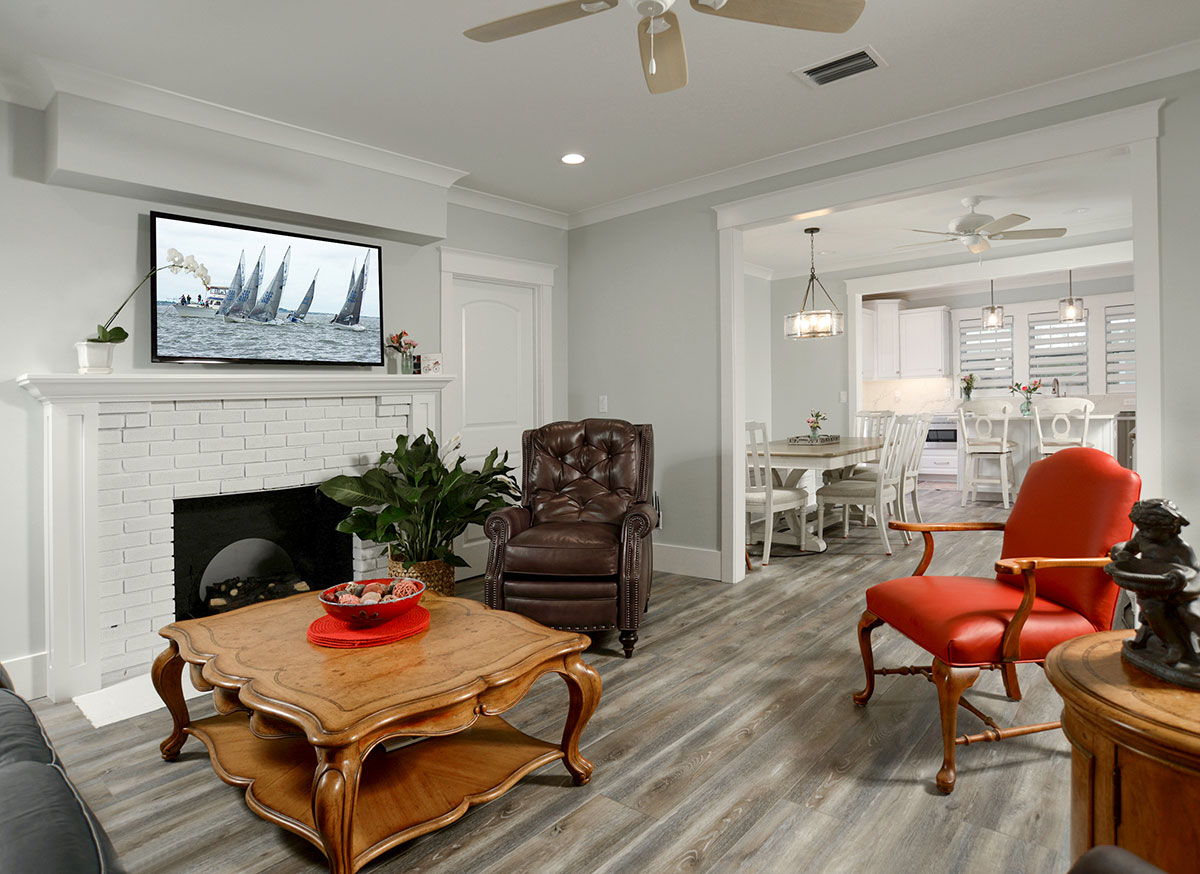
Project to restore Stuart bungalow included delays and lots of hard work
BY MARY ANN KOENIG
The seductive hook of home renovation TV programs creates the simple premise that turning ghastly into elegant is quick and easy.
But the Property Brothers, Good Bones, or Love It or List It can be more fantasy than reality. And A&E Network’s Orlando-based train wreck, Zombie House Flipping, makes the hard work look almost fun.
In the heart of downtown Stuart, however, on a beautiful, historical street, the mission to save a 100-year-old family home and preserve its original charm required time, an adaptable budget, and professional expertise by a team of specialists.
The heritage structure could otherwise have been sacrificed to builders.
In their quest to solve that challenge, the perfect couple met the perfect architects.
Homeowners Kathie and Marty Bielicki worked with Stuart-based architects Christina and Lance Vogl and together plotted strategy to restore a house that had been in the Bielicki family for more than 50 years.
COVID-related supply chain delays and several unforeseen issues of deconstructing and reassembling an old house increased the build time and the original budget, but the result is a complete transformation of the Seminole Street bungalow. Grouped together with other homes of the period, and down the street from the iconic Old Colorado Inn, the Bielickis’ house fits perfectly amid the historical surroundings.

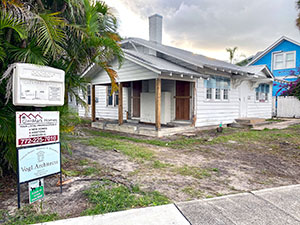
REVIVE RATHER THAN RELINQUISH
The land was purchased for just $750, according to Marty Bielicki, in 1915, a year after the town of Stuart was incorporated, and the residence was built in 1925. His mother, Theresa “Daisy” Bielicki, purchased it for $20,000 on Jan. 1, 1972. None of the home’s features, woodwork, kitchen, bath, or windows had been touched since it was first built.
Ownership of the home eventually passed to the Bielickis after the old bungalow had gone into a sad state of disrepair. They decided to revive it rather than relinquish it to developers who had approached them about buying the house to build condos on the property. Or possibly move the home to another location.
The couple had lived in Jensen Beach for several years but, “the idea of moving into downtown Stuart, intrigued us,” Marty Bielicki says. The couple wanted to be able to walk the boardwalk, and easily access Stuart’s numerous restaurants. “This area brought a lot of opportunities,” Kathie Bielicki says.
Marty Bielicki has been a well-known figure in Stuart for many years as a Martin County High School teacher, Dean of Students, and, most famously, a championship girls’ volleyball coach. He retired in 2014 but for 28 years he commanded the classroom teaching American history and excelled on the court turning out championship teams.
He took over coaching the team in 1982 and by 1994 it was a powerhouse, winning several state championships, the last one under his watch in 2009. And during his tenure, he even implemented changes to help fund the program. Selling ad space in the school program and on banners in the gym brought in enough revenue to fund team travel to the best tournaments, to purchase uniforms, and even meals for players. He was elected to the Florida High School Athletic Association Hall Of Fame in 2014.
But his proudest accomplishment, he believes, was in assisting his players to obtain scholarships. “I helped at least 80 girls get scholarships from junior colleges to four-year universities,” he says.
And while providing free volleyball lessons in the community, he met Kathie. They’ve been married for 37 years.
With that deep community connection, it’s no wonder the Bielickis were determined to revive his mother’s home and live in this historical section of Stuart.
The first hurdle was finding the architectural firm to manage the delicate balance of rebuilding the home, while retaining and enhancing the original style. They felt that the historic and legacy value of the home were worth saving.
The Vogls, a dual architect married couple, had moved to Stuart around 2008, and after receiving their licenses, opened their firm. They had walked or biked by the house numerous times and often wondered about it.
When the Bielickis contacted them, they were excited to take on the challenge. One of the things that drew the Bielickis to the Vogls was that they had studied architecture at Savannah College of Art and Design, in Savannah, Georgia.
“We knew they’d be able to work with old homes,” Marty Bielicki says. And back in his college days in Boulder, Colorado, Lance Vogl gained hands-on experience as a carpenter with a general contractor who did historical renovations.
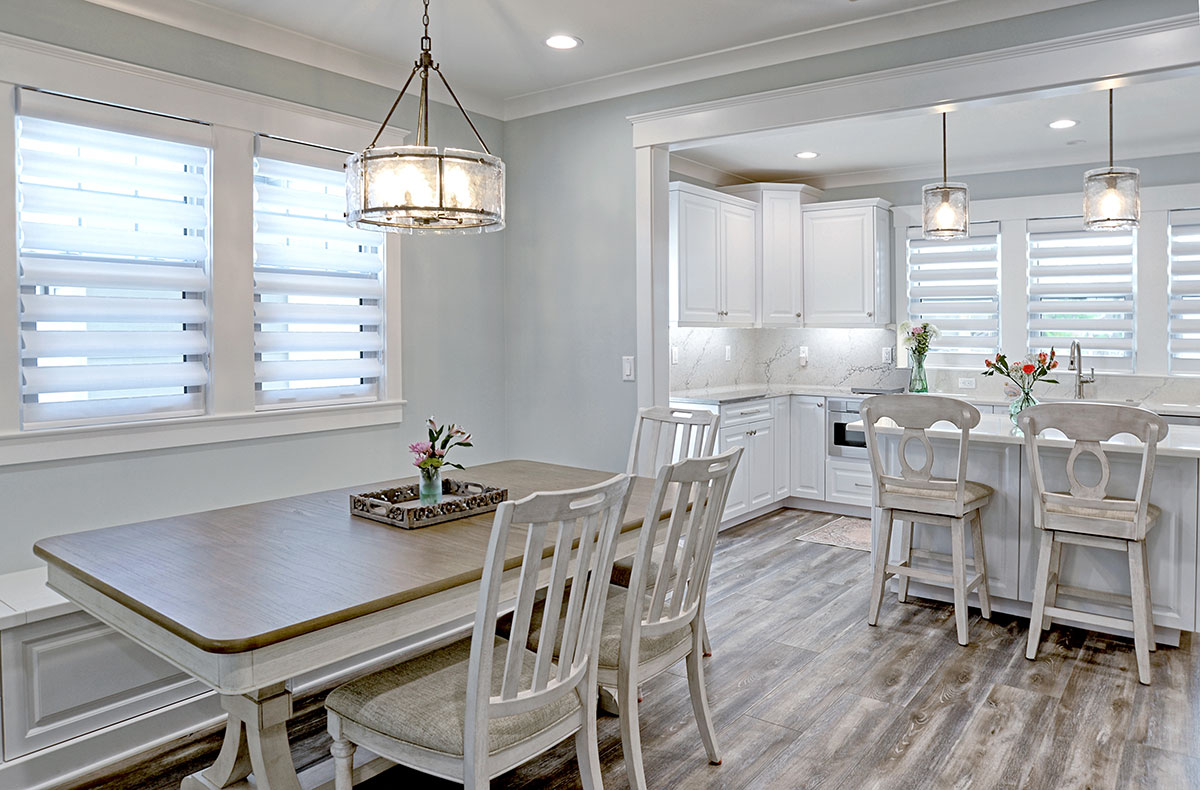
SHARED VISIONS
The Bielickis met with one architect who had, “quickly scribbled his ideas out on a piece of paper,” Kathie Bielicki says. But once they saw the Vogls’ work, the Bielickis’ vision dovetailed perfectly with the Vogls’ talents because they were methodical and precise.
“They took their time to come up with blueprints,” Kathie Bielicki says. “I could never in my wildest dreams have laid it out as they did.” It was a perfect coupling, “for them and us,” Christina Vogl says. “They’re the best clients we’ve ever had, and the nicest people on the planet.”
The renovations began in November 2021 and took the better part of a year to complete.
Since everything about the bungalow was original, the Vogls’ plan was to follow National Historic Preservation standard guidelines.
“We attempted to preserve as much of the character of the home as feasible without pushing the cost beyond the client’s budget,” Christina Vogl says.
The contractors, Canadian brothers Glen and Mark Hutchins of Glenmark Homes, had worked with the Vogls previously and their expertise was crucial when some trials of working with a 100-year-old structure were uncovered.
“The overall exterior envelope of the house was saved,” Glen Hutchins says. “The inner layout is new. Old homes are usually cut up with tiny rooms. The customer wanted a more open feel.”
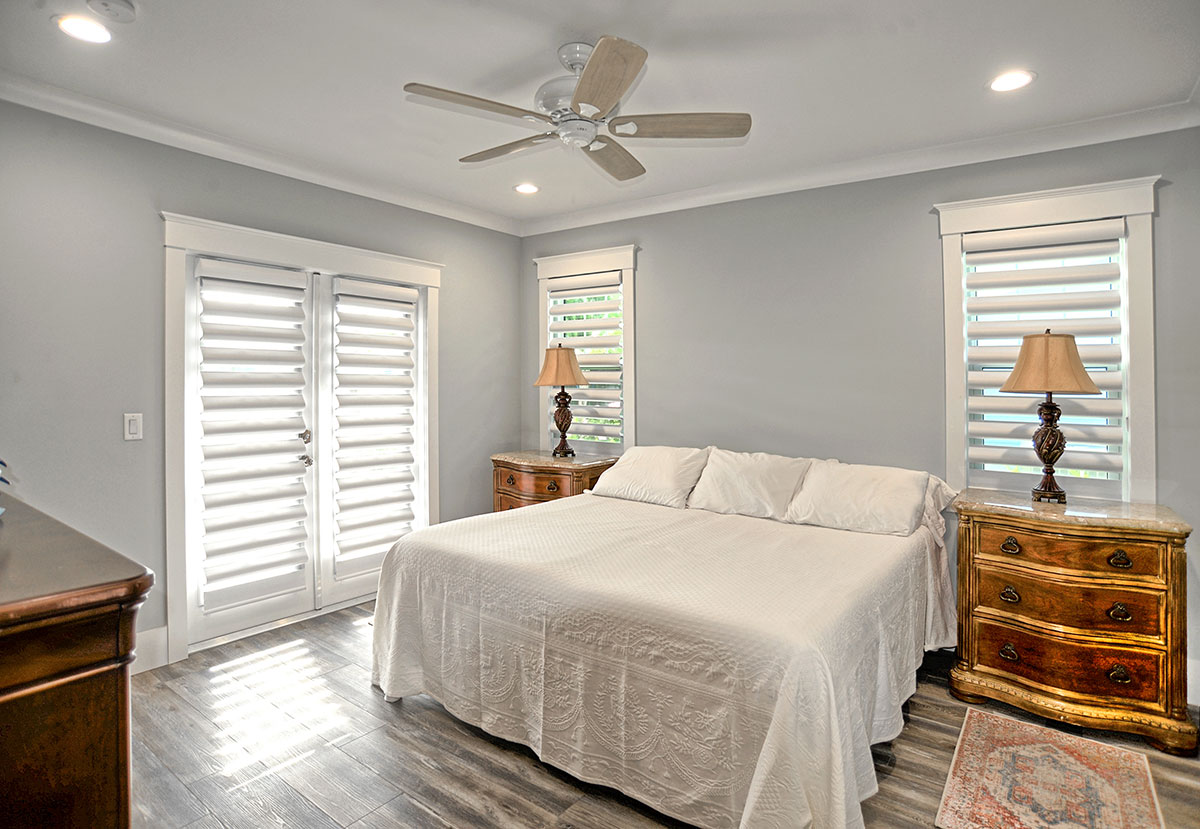
![Homeowners Kathie and Marty Bielicki [seated] with architects Christina and Lance Vogl.](https://indianrivermagazine.com/wp-content/uploads/2023/05/seated-are-Kathie-and-Marty-Bielicki-standing-are-architects-Lance-and-Christina-Vogl.jpg)
Contractors and architects worked to retain original characteristics of the 1920s bungalow. That design has its genesis in warm climates, and the derivation of the word bungalow is said to originate with huts in Bengal, India, which were emulated and improvised by the British.
“Traditional bungalow designs utilize features such as exaggerated roof overhangs, large porches, and bands of operable windows. These provide shading and natural air circulation,” Christina Vogl says.
Under the exaggerated roof overhangs, the architects created exterior brackets, an important design feature that also provides structural support. Lance Vogl believes, “it’s so easy to lose character on an historic home when you renovate it, it’s a big challenge and an important aspect.”
“Efficiency of space is also an essential feature of the bungalow and that was carefully considered throughout the design,” according to Christina Vogl.
“Some of the work was more complicated than originally anticipated,” Glen Hutchins says.
There was rot and the floors had issues with bowing because of wood spanning 16 feet with no support.
“That’s a long way for a floor,” he says. “It’s not bad for nonbearing, but you could jump on it and feel it bounce.” They put in beams and made the floor more structurally sound, and it leveled up. “The roof and ceilings also had to be straightened.”
Once they opened the walls, they found no exterior sheathing. “Back then you would have hoped for plywood or something,” Lance Vogl says. But they discovered that the siding had been nailed directly to the wall stud. “We had to pull off all the siding and put sheathing on and then new siding,” Christina Vogl says.
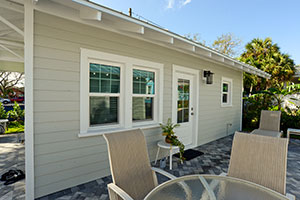
STRONGER THAN BEFORE
The result is a home up to date with today’s hurricane code. “We retrofitted, used tiedowns from the foundation all the way up to the roof,” Lance Vogl says. “We used strappings, clips, and sheathing, and put in hurricane windows.”
Glen Hutchins says, “The building is much stronger than before, we used Hardie plank siding, a cement-based product, so there’s no rotting or deterioration.”
Kathie Bielicki says, “One of the beauties of the project was that the architects and builders were constantly in contact with each other and that made it go smoothly.”
An entirely new garage was built, which the Vogls wanted to keep as minimal as possible.
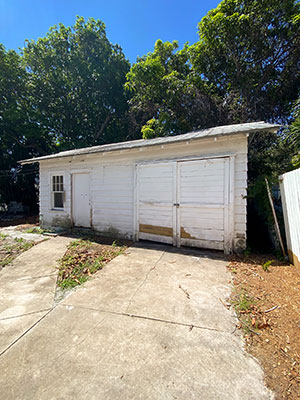
“The garage faces the street but is set back, with an attached breezeway. A lot of thought went into that, because we didn’t want it in the back corner and then have a driveway cover most of the property. The idea was utility and to not make the garage a focal point.”
A small cottage at the back of the home had to be taken down, but a new one was constructed using the same attention to detail and character.
The interior was gutted and rebuilt. Peeling yellow linoleum had to be pried up. Dark, closed off sections were opened. And the residence gained a sophisticated en suite primary bath, a big improvement over the tiny single bathroom that existed previously.
“The galley kitchen was like a closet, and the bathroom even smaller,” Marty Bielicki says. The house had three bedrooms crammed within 1,100 square feet. “You had to pass through the second bedroom to get to the third.”
Christina Vogl sketched out the bedroom spaces to reconstruct them as the dining and kitchen areas. The previous broom closet sized kitchen is now wide and spacious, with quartz countertops, 42-inch cabinets and an island.
The flooring, a silvery gray, luxury vinyl plank is a low maintenance architectural element that helps insulate the home and keep it energy efficient. Work was done on the original crawl space beneath the home. “It was sealed and encapsulated to prevent future humidity and moisture issues,” Lance Vogl explains.
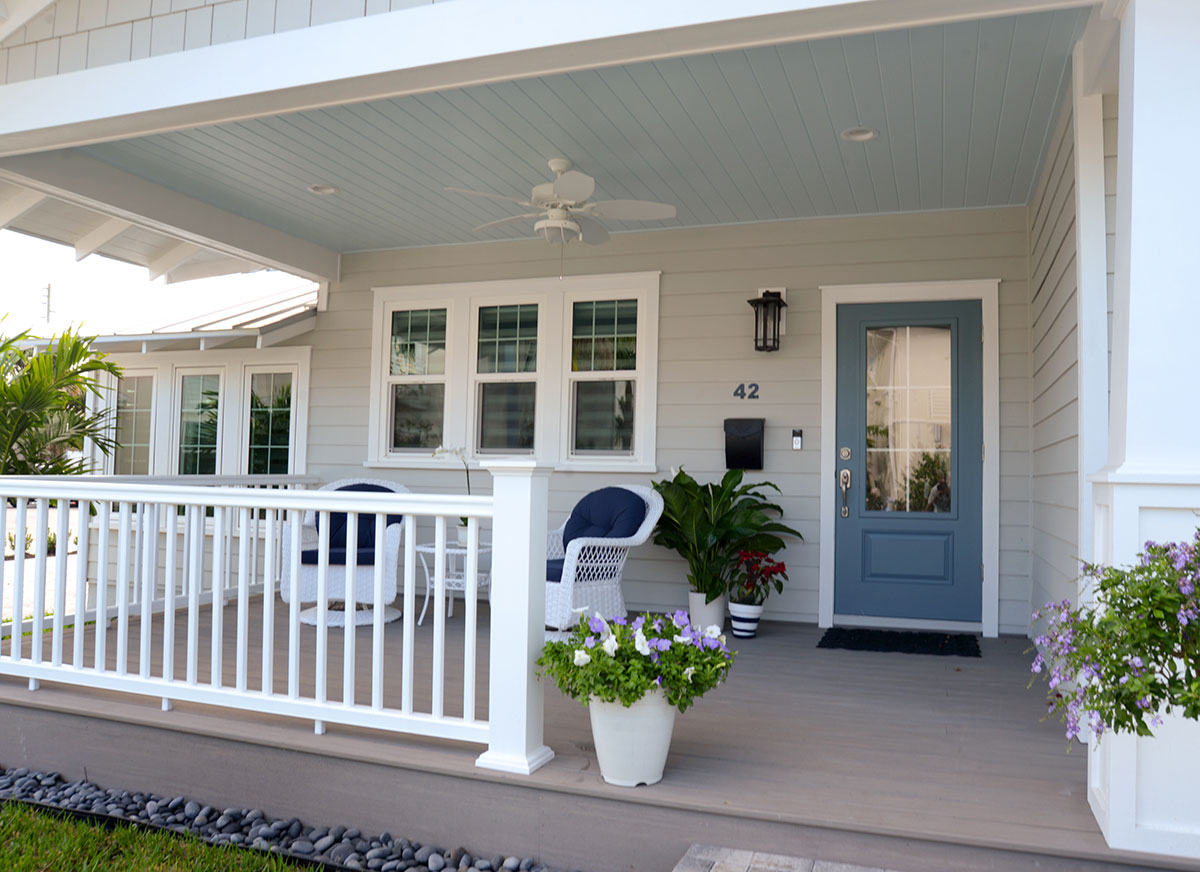

SOME THINGS WERE UNSALVAGEABLE
Most of the house was originally constructed of Miami Dade pine, a common building material for the period. “We didn’t know what we were facing until we pulled the finishes down,” Lance Vogl says. The Miami Dade pine had to be sacrificed because, “there was termite damage, but it was manageable.”
The original porch on the south side of the home was turned into a den, but the window effects were preserved in keeping with an original feature of traditional bungalows.
The architects added a customary bungalow feature, a raised front porch. “The contractors made the pedestals for the columns, and built them in the style of the day,” Lance Vogl says.
The mechanicals, electrical and plumbing were easily situated because of large attic space under the pitched roof, and air conditioning was added. “The house was hand-framed so integrating a regular traditional A/C system was not a problem,” Lance Vogl says.
The Bielickis have been settled into the home for a couple of months now and enjoying the fresh, new elements that still harken back to the original structure. “They did a great job, there are no rooms in the house that aren’t well lit by natural light and with a view,” Kathie Bielicki says.
While appreciating the reimagining of their bungalow, the Bielickis have also gained the lifestyle change that they were looking for.
See the original article in print publication
May 2023
